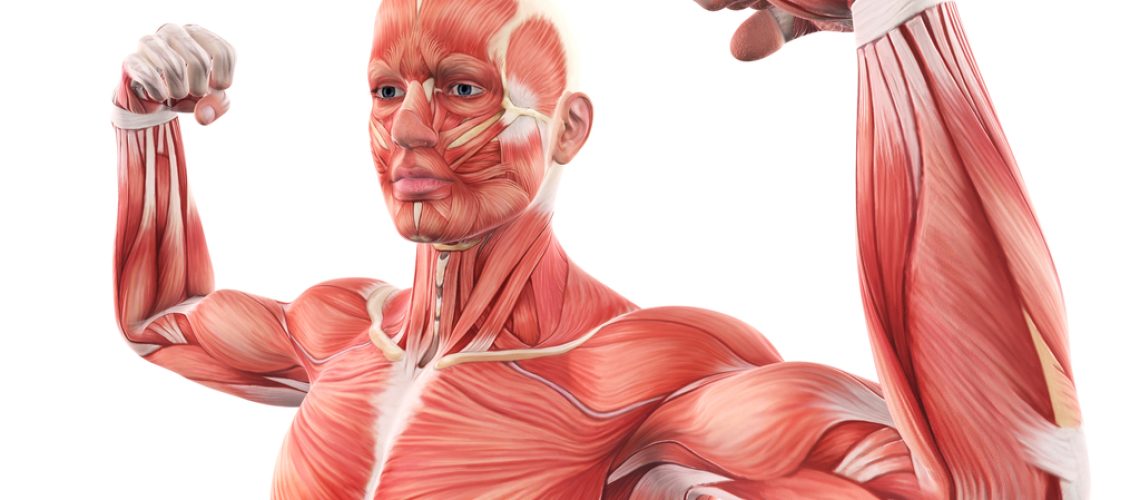Muscle Holds the Key to a Healthy Metabolism
Skeletal muscle is the largest metabolic organ in our body. It makes up about 40% of total body weight and accounts for nearly 50% of all protein in our body. Believe it or not, your muscles determine a lot about your metabolism! And ultimately muscles determine the precise mixture of macronutrient (protein, carbohydrates, and fats) that will optimize your metabolism.
Muscle Increases Your REE (Calories Burned at Rest)
Muscle is the most important organ of your body for energy expenditure and the only component of energy expenditure that is really in your can control. Resting Energy Expenditure (REE) or your resting metabolism is involuntary. Your heart, kidney, and other organs are running while you sleep. While at rest, muscles account for about 20% of REE or 300 calories.
However, voluntary movement might add as much as 4,000 additional calories to the daily needs for elite athletes or individuals engaged in heavy physical labor. On the other hand, if you’re daily agenda is mostly inactive and sitting in front of a screen, your muscles may burn as little as 300 to 400 extra calories. Because of the potential range of calorie expenditure by muscle, understanding your metabolic type is largely determined by your muscles.
Healthy Muscles Burn Fat
Skeletal muscle uses both fatty acids (fat) and glucose (a type of carb) as fuel. The exact proportions relate to your physical activity and what you eat. Healthy muscles in young, active individuals get 80% to 85% of their fuel from fatty acids. Dietary fats are critical fuels for your body. If this seems contrary to what you often hear from medical professionals and TV advertisements, you’re right. For nearly 50 years, supposed “health experts” have argued that dietary fat is bad for you, but the reality is, fat is the preferred fuel for virtually all the body (except for the brain and RBC).
In muscles, fatty acids are broken down or “burned” in the mitochondria. Mitochondria are often referred to as the furnace of the cell because they use oxygen to essentially burn the carbon contained in the macronutrients – fatty acids, glucose, and amino acids.
This process is called aerobic metabolism because it uses oxygen. Aerobic metabolism is ultimately limited by the number of mitochondria in your muscles and your ability to get enough oxygen to your muscles (i.e. breathing and circulation). During sleep and during normal daily activities, the predominate fuel for muscles is fat. Exercise training increases the number of fat-burning mitochondria in muscle.
Muscles Also Use Carbs as Fuel (But Not Always)
Skeletal muscle can also use glucose as a fuel. Carbohydrate use depends on physical exertion and diet. If you exercise at high intensity, such as fast running or singles tennis, your muscles must generate the ATP fuel quickly. Likewise, if you are not in good physical shape and find yourself out of breath after climbing a flight of stairs, you are also using glucose.
How Activity & Exercise Affects Fat Burning
The relative proportion of fuel coming from fatty acids shifts to glucose as the intensity of the activity or your level of exertion increases. Fatty acids are the predominate fuel for muscles up to a heart rate of about 100 to 130 beats per minute (estimated as 60% of maximum exertion). At this point, the amount of ATP required to perform the activity exceeds the mitochondria capacity and your ability to get oxygen to cells. At this point, muscles shift to what is called anaerobic metabolism, meaning muscles are generating ATP from glucose without oxygen. During anaerobic metabolism, muscles quickly generate the essential ATP for movement, but they also produce lactic acid and are in oxygen-debt. If this oxygen-debt and accumulation of lactic acid continue, muscles will fatigue and may experience cramping.
Getting the Right Balance of Macros at Meals

Your diet also affects the balance of fatty acids or glucose used by your muscles. Remember blood sugar is both essential for the brain but potentially toxic. If blood sugar gets too high (from too many carbs), it causes diabetes. Because blood glucose must be maintained within a narrow range (not too low; not too high), the body will always elect to eliminate glucose first after a high carbohydrate meal.
Typically, carbohydrates in a meal are digested and absorbed within one to two hours. These carbohydrates must be eliminated by burning as a fuel or storage as glycogen. If those two options don’t eliminate the glucose, the body must begin to alter other aspects of metabolism. The first change after a high carbohydrate meal will cause the body to stop burning fats and shift to remove the excess glucose.
The body shifts fats into storage and forces muscles to shift from 85% of fuel coming from burning fats to only 10% coming from fats and 90% coming from the carbohydrates. This shift in metabolism and fuel use requires a well-controlled and highly effective insulin response. Over time and with repeated exposure to high carbohydrate meals, the insulin response will become less effective (i.e. insulin resistance) and the body begins to exhibit signs of pre-diabetes.
In our next sessions, we will discuss the concepts for Carbohydrate Tolerance and the clinical symptoms of pre-diabetes to help you understand your metabolism.

